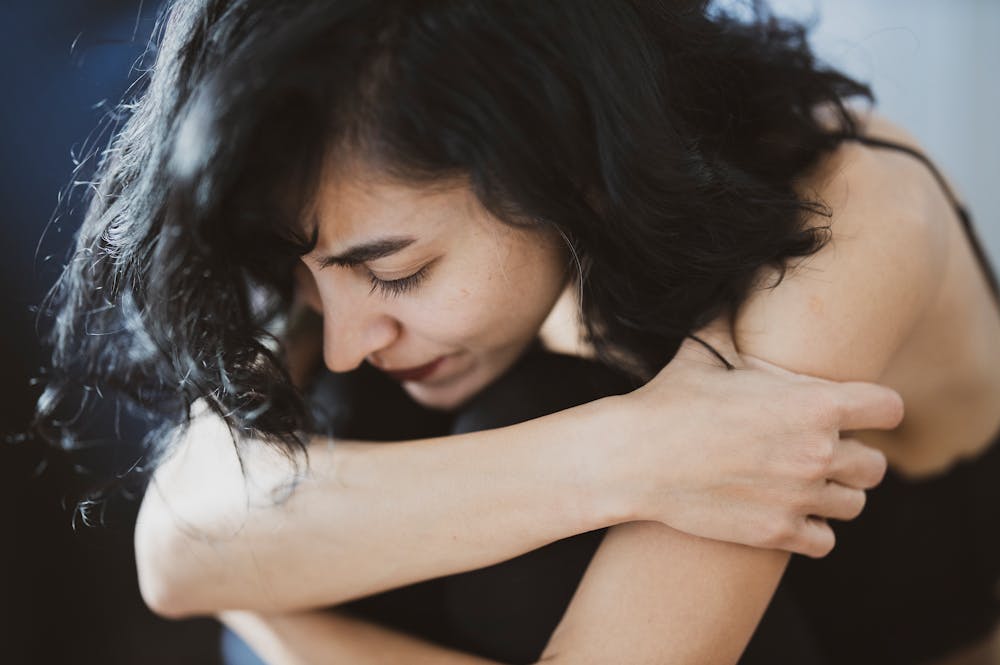Anxiety is a natural emotion, but when it becomes excessive, it can affect our quality of life. There are several meditation techniques for anxiety that help relieve its symptoms.
In this article, we’ll explore 7 practices that can be effective for those looking to manage anxiety in a simple and accessible way. Additionally, we’ll cover other ways to deal with this challenge and improve mental well-being. Happy reading!
What is anxiety, and why should we be concerned?
Anxiety is a natural emotion that we all experience in moments of uncertainty or when facing challenging situations. It acts as an alert mechanism, preparing our bodies to react to potential threats.
However, when this feeling becomes constant or disproportionate to the circumstances, it can develop into an anxiety disorder, significantly impacting our quality of life.
Anxiety disorders are characterized by excessive worry about future events, often accompanied by pessimism. This negative anticipation triggers sensations of danger, urgency, fear, and insecurity in the body, leading to physical reactions such as muscle tension, rapid heartbeat, sweating, and headaches.
There are different types of anxiety disorders, including:
- Generalized Anxiety Disorder (GAD): constant and intense worry about various aspects of life, even without clear reasons;
- Panic Disorder: sudden episodes of intense fear accompanied by physical symptoms like palpitations and shortness of breath;
- Social Anxiety Disorder: a heightened fear of social situations, leading to isolation;
- Agoraphobia: avoidance of places or situations where escaping might be difficult, causing a sense of entrapment.
The impacts of anxiety go beyond emotional distress. They can manifest physically, resulting in headaches, gastrointestinal problems, sleep disturbances, and muscle tension. Additionally, chronic anxiety can increase the risk of developing other mental disorders, such as depression.
Given this, it is essential to recognize the signs of anxiety and seek effective strategies to manage it. Among the available approaches, meditation techniques have proven particularly beneficial in alleviating anxious symptoms.

7 meditation techniques for anxiety to try today
Meditation is an ancient practice used to calm the mind, reduce stress, and promote well-being. In addition to being an excellent tool for dealing with anxiety, it can also improve concentration, enhance emotional resilience, and even help with sleep quality.
If you feel like your mind is always racing or you struggle to relax, meditation can be a great ally. There are various techniques, and you can try different approaches until you find the one that works best for you.
Here are 7 meditation techniques for anxiety that can help you find more balance in your daily life:
- Mindfulness meditation;
- Guided meditation;
- Deep breathing meditation;
- Transcendental meditation;
- Body scan meditation;
- Mantra meditation;
- Movement meditation.
Let’s explore them in more detail below.
1. Mindfulness meditation
Mindfulness meditation, or simply mindfulness, is one of the most effective practices for managing anxiety. It is based on the idea of being fully present in the moment, without judgments or distractions.
Anxiety often arises because we worry about the future or dwell on the past. Mindfulness teaches us to focus on the present, reducing these racing thoughts.
To practice it, find a quiet and comfortable place. Close your eyes and focus on your breathing. Feel the air entering and leaving your lungs, noticing every sensation in your body.
When your mind starts to wander, and it will, simply acknowledge the thought and gently bring your attention back to your breath.
Besides easing anxiety, this technique improves concentration, reduces stress, and even strengthens emotional intelligence. With regular practice, you learn to respond to daily situations more calmly and balanced.
You can start with just five minutes a day and gradually increase the time as you feel more comfortable. If you prefer, there are apps and guided videos that can help structure your practice.
The important thing is to cultivate the habit and allow mindfulness meditation to bring more balance to your routine.
2. Guided meditation
Guided meditation is an excellent option for those who struggle to meditate alone or are just starting out. In this technique, an instructor, through audio or video, leads the practice, helping direct attention and create a deep state of relaxation.
Typically, guided meditation includes breathing instructions, visualizations, and even positive affirmations. The guide may ask you to imagine a peaceful scene, like a beach or a blooming field, helping your mind disconnect from anxious thoughts.
This practice is especially useful for reducing anxiety because it provides external support to maintain focus, preventing the mind from getting lost in worries. Additionally, many guided meditations include soothing music and nature sounds, enhancing the sense of tranquility.
To start, simply search for guided meditation audios or videos on apps, streaming platforms, or YouTube. You can choose from different durations and styles based on your needs.
Over time, this technique can become a safe haven during anxious moments, providing calm, mental clarity, and expanded awareness.

3. Deep breathing meditation
Deep breathing meditation is a simple and effective technique for reducing anxiety almost instantly.
Breathing is directly connected to our nervous system: when we breathe rapidly and shallowly, the body perceives it as a danger signal, increasing stress levels.
On the other hand, slow and deep breathing sends a relaxation signal to the brain.
To practice this meditation, sit comfortably and close your eyes. Inhale deeply through your nose, counting to four, hold your breath for a few seconds, then exhale slowly through your mouth, counting to six.
Repeat this process for a few minutes, paying attention to each inhale and exhale.
This technique helps slow your heart rate, reduce muscle tension, and bring more mental clarity.
Additionally, it’s a practice that can be done anywhere and anytime: before an important meeting, during a stressful moment, or before bed.
4. Transcendental meditation
Transcendental meditation is a widely known technique used worldwide to reduce stress and promote well-being.
Unlike other forms of meditation, it doesn’t require effort to focus or control thoughts. Instead, the practice involves silently repeating a mantra, like the powerful "OM", which helps the mind enter a deep state of relaxation.
To practice, sit comfortably, close your eyes, and choose a mantra. It can be a sound with no specific meaning, a well-known mantra like “OM”, or a word that brings you peace.
Mentally repeat the mantra without worrying about controlling your breath or blocking thoughts. Over time, your mind will naturally quiet down, entering a more peaceful state of awareness.
Studies show that transcendental meditation can significantly reduce anxiety, improve mental clarity, and even lower blood pressure. Additionally, since it doesn’t require active concentration, it can be easier for those who struggle to stay focused for long periods.
It is recommended to practice it twice a day for about 15 to 20 minutes. With consistency, this technique can become a powerful ally in maintaining daily calm and balance.
5. Body scan meditation
Body scan meditation is a practice that helps reduce anxiety by directing attention to different parts of the body, releasing accumulated tension.
Anxiety often manifests physically, causing tension in the shoulders, tightness in the chest, or headaches. This type of meditation teaches you to notice these sensations and consciously relax them.
To practice, lie down or sit comfortably and close your eyes. Start by focusing on your breath for a few moments to calm your mind.
Then, direct your attention to your feet, noticing any sensations: warmth, tingling, tension, or relaxation. Gradually move upward through your body, passing through your legs, hips, abdomen, chest, arms, and head.
The goal is not to change anything but simply to observe how each part of your body feels at that moment. If you notice any tension, take a deep breath and imagine that the exhalation helps dissolve it.
This process increases body awareness and teaches you to recognize stress signals before they become overwhelming. In fact, this technique is especially useful before bedtime, helping you achieve deep relaxation.
6. Mantra meditation
Mantra meditation is a powerful practice that combines the repetition of words or sounds with breathing, helping to calm the mind and reduce anxiety.
Mantras can be sacred syllables like the "OM," which I mentioned earlier, positive words like "peace" or "serenity," or comforting phrases like "I am in balance."
To practice, sit comfortably, close your eyes, and take a few deep breaths. Choose a mantra and begin repeating it at a steady pace, either out loud or in a whisper.
The sound and vibration of the words help focus the mind and push away anxious thoughts. If your attention drifts, simply return to the mantra without judgment.
This technique works because repetitive sounds create a deep meditative state, slowing the flow of thoughts and bringing a sense of tranquility. Choosing positive words can also help reprogram negative thought patterns, promoting greater emotional balance.
Mantra meditation can be practiced by anyone, regardless of their meditation experience.

7. Moving meditation
Moving meditation is ideal for those who find it difficult to stay still during meditation.
Unlike traditional meditation, which is done in a static posture, this technique uses gentle, mindful movements to promote relaxation and reduce anxiety. Activities like walking meditation, yoga, tai chi chuan, and even slow dancing can be effective forms of this meditation.
To practice, choose a quiet environment and begin a light, rhythmic movement.
If you opt for walking meditation, for example, focus on the sensation of your feet touching the ground, your breath, and your body's movements. If you prefer yoga or tai chi, notice how each posture influences your energy and mental state.
The key to moving meditation is mindfulness: instead of letting your mind wander to worries, stay present, feeling every detail of your bodily experience. This helps reduce restlessness and cultivate a sense of calm and presence.
This technique is especially useful for those who struggle to meditate while sitting or need an active way to quiet the mind.
Other ways to manage anxiety
While meditation is an effective practice for reducing anxiety, there are other approaches that can also help manage symptoms in a positive way.
Physical exercise
Regular physical activity is one of the most effective ways to combat anxiety.
Activities like walking, running, dancing, or yoga help release endorphins, the “feel-good” hormones, that naturally reduce stress and improve mood.
But that’s not all. Exercise also improves sleep quality, which is an important factor in controlling anxiety levels.
Cognitive-behavioral therapy (CBT)
Cognitive-behavioral therapy (CBT) is a therapeutic approach focused on identifying and modifying negative thought patterns that contribute to anxiety.
Through sessions with a psychologist, CBT helps individuals understand their emotions and develop healthier ways of thinking and reacting to stressful situations.
Muscle relaxation techniques
Progressive muscle relaxation is an effective way to relieve the physical tension caused by anxiety. It involves tensing and then relaxing different muscle groups in the body, one at a time.
This process helps individuals become aware of the difference between tension and relaxation, promoting balance between body, mind, and spirit.
Reducing caffeine and alcohol consumption
Excessive caffeine and alcohol consumption can worsen anxiety symptoms. Caffeine can cause nervousness and insomnia, while alcohol, despite its initial relaxing effect, can disrupt neurotransmitter levels and increase anxiety over time.
Cutting back or eliminating these substances can contribute to greater emotional balance and reduce anxious episodes.
I hope this content has helped you in some way! Why not explore other articles on the blog to discover new paths of self-knowledge, consciousness expansion, and spiritual growth? See you soon!
May the Light of Love be the guide of all paths, at all times, in all circumstances, with all the people. And may Love foster Peace!

